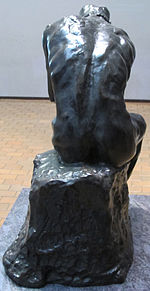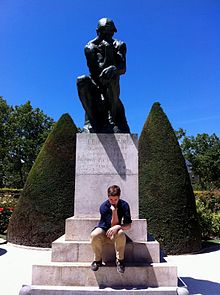Contents
[hide]Origins[edit]
This detail from the Gates of Hell was first named The Thinker by foundry workers, who noted its similarity to Michelangelo's statue of Lorenzo de Medici called "Il Penseroso" (The Thinker).[2] Rodin decided to treat the figure as an independent work, at a larger size. The figure was designed to be seen from below, and is normally displayed on a fairly high plinth, though the heights chosen by the various owners for these vary considerably.
Casts[edit]
University, NYC
Rodin made the first small plaster version around 1880. The first large-scale bronze casting was finished in 1902 but not presented to the public until 1904.[dubious ] It became the property of the city of Paris thanks to a subscription organized by Rodin admirers, and was put in front of the Panthéon in 1906. In 1922, it was moved to the Hôtel Biron, which had been transformed into the Rodin Museum.
The first cast sculpture can be found in front of Grawemeyer Hall on the University of Louisville Belknap Campus in Louisville, Kentucky. Made in Paris, it was first displayed at the St. Louis World's Fair in 1904 and was then given to the city. This sculpture was the only cast created by the lost-wax casting method.[3][citation needed]
References[edit]
- Jump up ^ Elsen, Albert L., Rodin's Gates of Hell, University of Minnesota Press, Minneapolis Minnesota, 1960 p. 96
- Jump up ^ Elsen, Albert L., Rodin's Gates of Hell, University of Minnesota Press, Minneapolis Minnesota, 1960 p. 77
- Jump up ^ "U of L Belknap Campus Tour, page 2". University of Louisville. 2000. Archived from the original on February 26, 2011. Retrieved 15 November 2010.
External links[edit]
| Wikimedia Commons has media related to Le Penseur. |
- Rodin: The B. Gerald Cantor Collection, a full text exhibition catalog from The Metropolitan Museum of Art, which contains material on The Thinker
- The "Penseur", a poem by Philadelphia poet Florence Earle Coates.
- Link to The Thinker at the official Web site of the Musée Rodin.
- The Thinker Inspiration, Analysis and Critical Reception
- The Thinker project, Munich. Discussion of the history of the many casts of this artwork.
- The Thinker, Iris & B. Gerald Cantor Center for Visual Arts at Stanford University, Object Number 1988.106, bronze cast No.
- Auguste Rodin and The Thinker, The story behind his most iconic sculpture of all-time at biography.com.




No comments:
Post a Comment